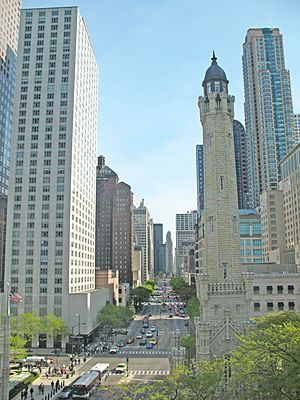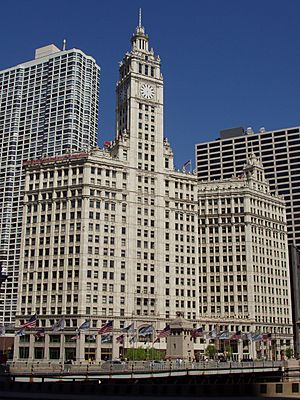Near North Side, Chicago facts for kids
Quick facts for kids
Near North Side
|
|
|---|---|
| Community Area 08 - Near North Side | |
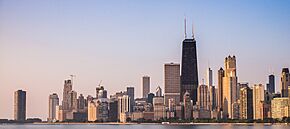
Near North Side skyline
|
|
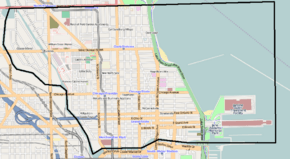
Streetmap
|
|
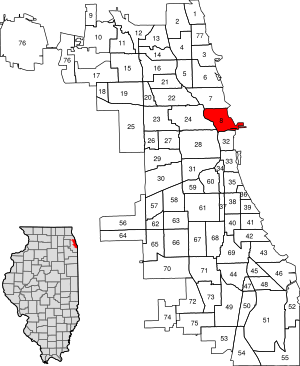
Location within the city of Chicago
|
|
| Country | United States |
| State | Illinois |
| County | Cook |
| City | Chicago |
| Neighborhoods |
List
Goose Island
Old Town Gold Coast Cabrini–Green Near North Side Magnificent Mile River North Streeterville Dearborn Parkway State Parkway |
| Area | |
| • Total | 2.72 sq mi (7.04 km2) |
| Elevation | 587 ft (179 m) |
| Population
(2020)
|
|
| • Total | 105,481 |
| • Density | 38,806/sq mi (14,983/km2) |
| population up 44.9% from 2000 | |
| Demographics (2021) | |
| • White | 69.4% |
| • Black | 6.8% |
| • Hispanic | 6.2% |
| • Asian | 13.9% |
| • Other | 3.7% |
| Educational Attainment (2021) | |
| • High School Diploma or Higher | 98.3% |
| • Bachelor's Degree or Higher | 84.3% |
| Time zone | UTC-6 (CST) |
| • Summer (DST) | UTC-5 (CDT) |
| ZIP codes |
60611, most of 60610, and parts of 60654 and 60642
|
| Median household income (2021) | $114,790 |
| Source: U.S. Census, Record Information Services | |
The Near North Side is one of Chicago's 77 community areas. It is in the central part of Chicago, north and east of the Chicago River. To its east is Lake Michigan, and its northern border is North Avenue.
In 2020, the Near North Side had over 105,000 residents. This made it the largest community area in Chicago by population. It also has many skyscrapers, second only to the Loop. This area is known for being very wealthy. It includes famous places like the Gold Coast, Magnificent Mile, and Navy Pier.
The Near North Side is the oldest part of Chicago. In the 1780s, Jean Baptiste Point du Sable built the first known permanent home here. This was on the northern banks of the Chicago River. Today, this spot is marked by Pioneer Court. The area around Rush and Erie streets was once called McCormickville. This was because many members of the famous McCormick family built their large homes there.
Contents
Exploring Near North Side Neighborhoods
The Near North Side is home to several unique neighborhoods. Each one has its own history and special features.
| Historical population | |||
|---|---|---|---|
| Census | Pop. | %± | |
| 1910 | 97,230 | — | |
| 1920 | 83,936 | −13.7% | |
| 1930 | 79,554 | −5.2% | |
| 1940 | 76,954 | −3.3% | |
| 1950 | 89,196 | 15.9% | |
| 1960 | 75,509 | −15.3% | |
| 1970 | 70,329 | −6.9% | |
| 1980 | 67,167 | −4.5% | |
| 1990 | 62,842 | −6.4% | |
| 2000 | 72,903 | 16.0% | |
| 2010 | 80,484 | 10.4% | |
| 2020 | 105,481 | 31.1% | |
| 2021 (est.) | 98,505 | 22.4% | |
Discovering the Gold Coast
The Gold Coast is famous for its fancy high-rise apartments and stone mansions. Its borders are generally North Avenue to the north, Lake Michigan to the east, Chicago Avenue to the south, and Clark Street to the west.
This area became home to very rich people starting in 1885. That's when Potter Palmer, a successful merchant, built a huge castle-like home on Lake Shore Drive. Over time, many of Chicago's wealthy families moved here.
The Gold Coast has many upscale shops and boutiques. You can also find luxury car dealerships and some of Chicago's best restaurants here. Famous spots include Lou Malnati's Pizzeria, Gibsons Steakhouse, and the original Morton's The Steakhouse.
The "Gold Coast Historic District" was added to the National Register of Historic Places in 1978. Students in this area attend Chicago Public Schools like Ogden School and the private Latin School of Chicago.
Exploring Old Town
Old Town is a historic Chicago neighborhood. It is known for its many older Victorian-era buildings. Its main borders are North Avenue to the north and Division Street to the south.
In the 1950s, many of the first people from Puerto Rico to move to Chicago lived here. Old Town is home to St. Michael's Church. This church was built for German immigrants and was one of only seven buildings to survive the Great Chicago Fire.
Many streets and alleys in Old Town are very old. They were built before the Great Chicago Fire. Because of this, they don't always follow Chicago's usual grid pattern. In the 1930s, artists moved to the area, creating an art community.
Old Town is home to The Second City improvisational comedy group. Many famous comedians and actors started their careers there. Old Town has three "L" train stations: North/Clybourn, Sedgwick, and Clark/Division.
Visiting Goose Island
Goose Island is a 160-acre island in Chicago. It is completely surrounded by the city. The North Branch of the Chicago River is on its west side. The North Branch Canal is on its east side. The canal was dug in 1853 for industrial uses, which created the island.
Irish immigrants settled on the island and named it Goose Island. They also called it Kilgubbin, after their original home in Ireland. The Goose Island Brewery makes a beer called Kilgubbin Red Ale to honor this name.
The Wrigley Global Innovation Center is on the north end of Goose Island. It is a large facility that opened in 2005. You can reach the island by train, bike, or walking using the Cherry Avenue Bridge. There is also a Chicago Water Taxi service dock for seasonal access.
On the south end of the island is Kendall College's Riverworks campus. This southern part of the island is being redeveloped. New upscale homes and apartments are being built there.
Exploring River North
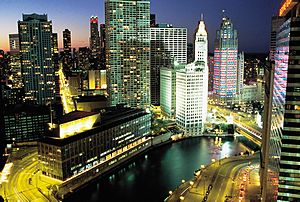
River North is a neighborhood known for its great restaurants, art galleries, and fun nightlife. It is bounded by Michigan Avenue to the east, Chicago Avenue to the north, and the Chicago River to the south and west.
Many companies have their offices here, including ConAgra, Groupon, and Motorola Mobility. Famous buildings in River North include the Merchandise Mart, the Wrigley Building, Holy Name Cathedral, the Marina City towers, and the House of Blues.
River North's Past: Smokey Hollow
At the start of the 1900s, River North was called Smokey Hollow. This was because of the many factories and forges in the area. The smoke from these factories was often so thick it blocked the sun. Smokey Hollow was an important transportation hub. Railroad tracks connected ports along the Chicago River to other areas. The Merchandise Mart was once a large storage warehouse for goods.
River North's Past: Little Sicily
Little Sicily was another name for a part of River North. This was where many Italian immigrants settled. The first Italian Catholic Church in Chicago, Assumption, was on Illinois Street. It served all Italians in the area.
Cabrini–Green's Transformation
The Near North Side once included the public housing project called Cabrini–Green. It was made up of tall and mid-rise apartment buildings. These buildings were built in the 1950s and 1960s. The area was once part of the Italian neighborhood called Little Sicily.
Over time, the area changed. The Cabrini–Green buildings were taken down, with the last one demolished in 2011. New upscale homes and businesses have replaced them. This change was part of the growth of nearby Old Town, Gold Coast, and River North.
How River North Got Its Name
The River North neighborhood got its name from a real estate developer named Albert Friedman. In 1974, he started buying and fixing up buildings in the area. Much of the area was run-down at the time. To attract new businesses, Friedman started calling the area "River North."
Soon, photographers, ad agencies, and art galleries moved in. They liked the low-cost spaces. This led to the creation of the River North Gallery District. It has the largest number of art galleries in the United States outside of Manhattan. The area also has many restaurants, bars, and entertainment spots. Between 2000 and 2010, the population in River North grew by almost 82%.
River North has several distinct areas:
- The gallery district, mainly along Superior and Huron streets.
- A theme-restaurant area, around Clark and Ontario.
- The cathedral district, with new skyscrapers near Holy Name Cathedral and St. James Cathedral.
- A design district, with shops selling home furnishings.
- Kingsbury Park, an area with new homes around Montgomery Ward Park.
River North is served by four CTA "L" train stations: Chicago Avenue (Red Line), Grand Avenue (Red Line), Chicago Avenue (Brown Line), and Merchandise Mart (Brown Line).
Exploring Streeterville
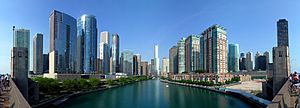
Streeterville is the easternmost neighborhood in Chicago north of the Chicago River. It is bordered by the river to the south, Michigan Avenue to the west, and Lake Michigan to the north and east.
Streeterville is home to some of Chicago's tallest skyscrapers, like the John Hancock Center. It also has many upscale stores, hotels, and restaurants. Northwestern University has several campuses here. These include Northwestern Memorial Hospital and the Feinberg School of Medicine.
Navy Pier, a top tourist attraction in the Midwest, is located in Streeterville. The neighborhood also houses the Museum of Contemporary Art, Chicago.
Walking the Magnificent Mile
The Magnificent Mile is a famous part of North Michigan Avenue. It stretches between the Chicago River and Oak Street. This area is filled with luxury stores, restaurants, office buildings, and hotels. Many major media companies and advertising agencies are also located here. This includes the Chicago Tribune newspaper.
The street is home to Chicago's famous Water Tower landmark. You can also find Water Tower Park with its historic clock. The eight-level Water Tower Place shopping center is right next door. North of the shopping center is the famous John Hancock Center. You can also see the Art Deco Palmolive Building and the fancy Drake Hotel, which sits across from a beach.
Fun Attractions in Near North Side
|
|
|
|
|
Economy and Businesses
Many important companies have offices in the Near North Side. Google's Chicago offices are in the Dearborn Plaza building. Etihad Airways and Qatar Airways have offices in the John Hancock Center. The Wrigley Company used to have its main office in the Wrigley Building. In 2012, they moved to Goose Island, which is also in the Near North Side.
Other companies that once had offices here include American Airlines (through Simmons Airlines), Indigo Airlines, and the Tribune Company. Potbelly Sandwich Works also used to be in the Merchandise Mart complex.
Diplomatic Missions
Several countries have their consulates in the Near North Side. A consulate is like a smaller embassy that helps citizens and promotes trade. The main building for the Consulate-General of the People's Republic of China is here.
Other countries with missions include Austria, Bosnia and Herzegovina, Brazil, Bulgaria, Chile, Colombia, Denmark, Egypt, Germany, Greece, India, Republic of Ireland, Italy, Japan, South Korea, Lithuania, Poland, Serbia, Switzerland, Thailand, the United Kingdom, and Ukraine.
Some trade missions also have offices here. These include the Austrian Trade Commission, the Italian-American Chamber of Commerce Midwest, and the Trade Commission of Spain.
Education and Learning
Colleges and Universities
The Near North Side is home to several colleges and universities:
- Northwestern University School of Law
- Northwestern University Medical School
- Loyola University Chicago School of Law
- Loyola University Chicago Graduate School of Business and other schools
- The Chicago School of Professional Psychology
- University of Chicago's Booth School of Business Gleacher Center
- Erikson Institute
- Moody Bible Institute
Primary and Secondary Schools
Chicago Public Schools serves the students living in the Near North Side.
- Zoned elementary schools include Ogden International School.
- Some students attend Wells Community Academy High School. Others go to Lincoln Park High School.
Magnet schools:
- Walter Payton College Prep
Charter schools:
- Noble Academy
Private schools:
Adult Education
- Feltre School
Libraries for Everyone
- Newberry Library
- Chicago Public Library Near North Branch
- Chicago Public Library Water Works Branch
Notable People from Near North Side
Many interesting people have lived in the Near North Side:
- Conor Allen: An AHL player. He grew up in Old Town.
- Henry A. Courtney Jr. (1916–1945): A Marine Corps officer who received the Medal of Honor. He lived here while studying law.
- Mitch Glasser (born 1989): An Israeli-American baseball player.
- Nellie Grant (1855–1922): Daughter of President Ulysses S. Grant. She lived on North Lake Shore Drive.
- Dwight H. Green (1897–1958): The 30th Governor of Illinois. He lived on North Lake Shore Drive.
- Robert Halperin (1908–1985): An athlete and businessman who started Lands' End. He lived in the Near North Side.
- James S. Kemper (1886-1981): An insurance executive and former United States Ambassador to Brazil. He lived on North Lake Shore Drive.
- Suzanne Le Mignot: A television news anchor and reporter.
- Polo G (born 1999): A famous rapper.
- Gene Siskel (1946–1999): A well-known film critic. He lived on N. Astor St.
- Jesse White (born 1934): The 37th Illinois Secretary of State. He lived on West Division Street as a child.


